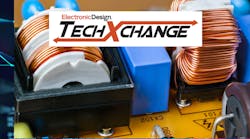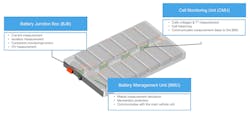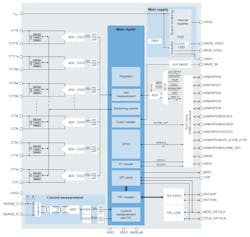NXP Rolls Out Next Generation of Battery-Cell Controller ICs
When it comes to pushing the limits of lithium-ion (Li-ion) batteries, companies are investing the most in new materials and chemistries such as solid-state electrolytes and lithium-metal anodes, or new hardware designs such as cell-to-pack architectures. But these changes are slow to mature and often come with tradeoffs in performance, cost, safety, and reliability.
A potentially more impactful area of innovation is in the battery-management system (BMS). It controls how each cell in the pack charges, discharges, and ages.
Now, NXP is trying to boost energy density, charging speed, safety, and cycle life without rethinking the underlying chemistry. The company recently introduced a new family of 18-channel battery-cell controller ICs—the BMx7318 and BMx7518.
These chips can measure voltages in up to 18 battery cells at a time and track up to 12 temperature sensors simultaneously. They feature configurable averaging of cell voltage measurements through digital filtering and support passive cell balancing to maximize the usable capacity and integrated current sensing.
Based on a more advanced analog front-end architecture and analog-to-digital converters (ADCs) on each input channel, they’re designed to deliver faster, more accurate insights into what’s happening inside a battery.
The new family of ICs deliver high-resolution voltage, current, and temperature sensing at the cell and pack levels, enabling more precise estimates of the state of charge (SOC) of the battery pack at any point in time as well as the state of health (SOH). NXP said the chips are automotive- and industrial-grade, complying with ASIL C (under ISO 26262) and SIL-2 (under IEC 61508) standards for functional safety. That brings more robustness and reliability to everything from electric vehicles to grid-connected energy storage systems (ESS).
“By integrating advanced ADC architecture, high-current balancing, and robust EMI immunity, we enable our customers to design more efficient and scalable energy systems,” said Naomi Smit, VP and GM of Driver and Energy Systems.
The BMS: A Big Deal for Performance, Reliability, and Safety
As demand for scalable and cost-effective energy storage explodes, battery management is playing a key role in everything from EVs to backup power supplies in AI data centers.
A Li-ion battery is a finely tuned system where complex chemical and electrical processes collide. In EVs, for instance, they’re comprised of tens to hundreds—and sometimes thousands—of electrochemical cells, typically adding up to voltages of between 400 and 800 V, even reaching 1,000 V in rare cases. While the latest battery chemistries are characterized by high energy density, they’re also highly sensitive to disturbances.
>>Check out these TechXchanges for similar articles and videos
The sensitivity isn’t just a product of the minute impurities or deviations that can occur during the manufacturing process. The battery pack can also react to real-world operating conditions once installed in an EV or AI data center or connected to solar, wind, and other renewable-energy systems. Electrical variations during charging or discharging; harsh temperatures or other environmental factors; and mechanical pressure, vibrations, and physical stress can all influence the battery’s performance and longevity.
In EVs, physical damage to the battery, such as punctures or deformation, may hurt performance or, in some cases, result in short circuits or other faults that can cause severe damage. And overcharging or undercharging typically shortens the battery’s lifespan or interrupts the charging process prematurely. One of the main risks is thermal runaway, a condition in which one of the battery cells overheats uncontrollably. It can trigger a chain reaction that spreads to other cells, potentially causing the pack to ignite or explode.
As battery cells charge and discharge, they also literally swell and shrink. This leads to volume changes that can reach up to 15% in rare cases, causing batteries to age prematurely and lose storage capacity.
The BMS ensures every cell in the battery pack operates at the voltage, current, and temperature levels that define the safe operating area (SOA) of a specific chemistry. Several firms, including Eatron and Qnovo, are adding artificial intelligence (AI) into BMS software to enhance state estimation and optimize battery operation in real-time, wringing more performance out of existing batteries without altering the chemistry.
One of the most important jobs of the BMS is to accurately estimate the SOC, which quantifies the amount of energy remaining in the battery, and the SOH, which reflects the condition and capacity of the aged battery compared to its original state. Maximizing the longevity of the battery and keeping tabs on its remaining lifespan is key to end-users. This is because battery packs can cost up to thousands of dollars to produce, accounting for as much as 30% to 40% of the average EV's cost.
Other functions include safety monitoring, and that entails continuously monitoring the voltage, current, and temperature sensors around the battery pack to prevent hazards. It also takes care of cell balancing, which ensures uniform charging and discharging across the pack. The BMS also controls cooling systems to keep the cells and pack within an optimal temperature range, crucial for safety, longevity, as well as performance. Finally, the BMS communicates the battery’s status to end-users and the charging system.
Inside NXP’s New Family of Battery Cell Controller ICs
To make sure the battery operates safely and with optimal performance, the BMS needs to closely monitor not only the voltages of the cells, but also the voltages, currents, and thermal conditions of the larger pack.
NXP said its new battery-cell controller ICs are core building blocks of the BMS, as they can accurately measure cell voltages to within 1 mV while covering a cell voltage range of –0.3 to 5.0 V. They’re able to monitor voltages in up to 18 cells at a time and integrate current sensing through a separate shunt resistor. This gives the BMS a more complete picture of what’s happening inside each cell, yielding more accurate state estimation. Several chips can be daisy-chained to keep track of a larger number of cells.
The new controllers are based on a more advanced analog front-end architecture that keeps the cell sampling channels completely independent, reducing crosstalk. It’s also rigorously designed and tested to deter electromagnetic interference (EMI).
According to NXP, the controllers feature all-channel parallel cell balancing up to 150 mA—capable of operating in environments up to 125°C—with a single channel achieving up to 300 mA. This significantly improves how efficiently it balances out the current levels in each of the battery cells in the string. The chips use the same pinout for cell measurement and cell balancing, reducing the cost of the external filter network.
Typically, a battery-cell controller is located inside a single-function system called the cell monitoring unit (CMU), which monitors the cell level. But the new NXP chips also add up to 12 channels of analog voltage measurements to measure conditions inside the larger battery pack. They measure the voltage level of the pack, the condition of the insulation inside it, and the temperatures in different parts of it. A hardware alarm pin means it can respond rapidly to overcurrent events, improving system reliability.
By measuring all of these parameters, NXP said it can act as one of the other main building blocks of a BMS: a battery disconnect unit (BDU). Also called the battery junction box, this unit is used to connect the high-voltage battery pack to the loads—the traction inverter and the onboard charger (OBC) in the case of an EV—and disconnect it when danger arises. The BDU is typically located inside or on top of the battery pack.
The BDU acts as the safety monitor for the system, overseeing voltages, currents, and other conditions at the pack level to prevent short circuits and other hazards from impacting battery performance or causing it to overheat uncontrollably. One of its main responsibilities is monitoring the integrity of insulation used for thermal management inside the battery. Insulation failure can decrease the internal resistance of the battery, potentially shortening the battery’s lifespan or raising the risk of fire.
The new BMS chip uses NXP’s proprietary isolated daisy-chain protocol called TPL to connect several of the chips together in battery packs with larger numbers of cells. It uses a serial peripheral interface (SPI) bus to communicate with the safety MCU at the heart of the BMS. The company said the new BMx7318 and BMx7518 add a robust, isolated SPI-to-TPL communication bridge, giving it the ability to act as a gateway for the BMS. A separate transceiver IC is required to connect the BMS to CAN or other networks.
A Mini Battery-Management System on a Chip?
By sensing voltages, currents, and temperatures in both the battery cells and the pack and communicating them to other parts of the system, NXP said the BMx7318 and BMx7518 act as mini battery-management systems. The chips can support “semi-centralized” architectures, which yield system-level cost savings while enhancing the performance and stability of the overall BMS. This not only reduces the complexity and cost of hardware designs, but it can also help simplify software development.
By integrating more of the BMS into a single EMI-robust chip, NXP said it’s able to reduce external component count by up to 50%, saving space and cutting costs for OEMs and Tier 1 suppliers. The chips can be used across industries due to the wide range of configurations and their pin-to-pin compatibility. That also enables designers to upgrade or modify designs without overhauling the hardware. The system features an ultra-low-power mode that consumes only 5 µA, designed to meet the needs of long-term energy storage.
NXP plans to roll out the new family of battery-management ICs more broadly in late 2025.
>>Check out these TechXchanges for similar articles and videos
About the Author
James Morra
Senior Editor
James Morra is the senior editor for Electronic Design, covering the semiconductor industry and new technology trends, with a focus on power electronics and power management. He also reports on the business behind electrical engineering, including the electronics supply chain. He joined Electronic Design in 2015 and is based in Chicago, Illinois.





